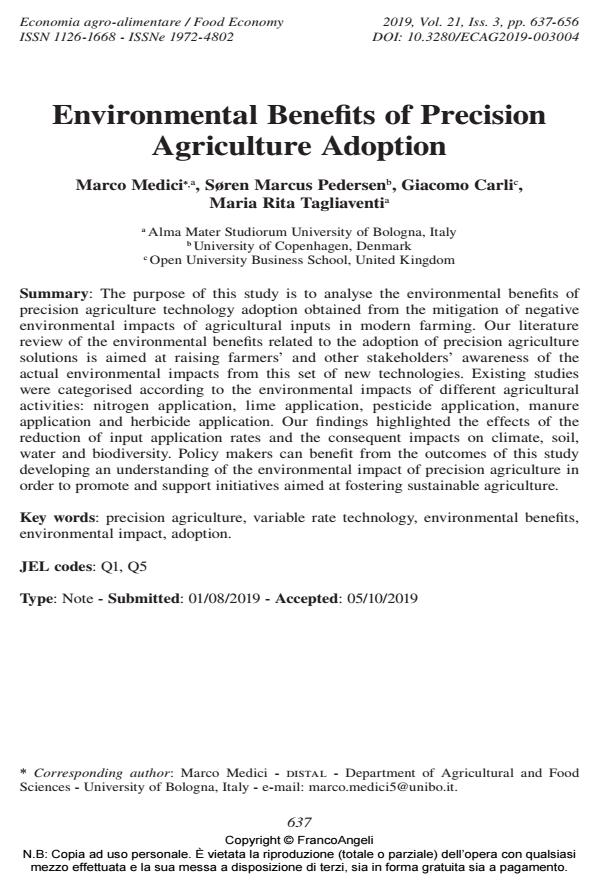Environmental Benefits of Precision Agriculture Adoption
Journal title ECONOMIA AGRO-ALIMENTARE
Author/s Marco Medici, Søren Marcus Pedersen, Giacomo Carli, Maria Rita Tagliaventi
Publishing Year 2020 Issue 2019/3
Language English Pages 20 P. 637-656 File size 147 KB
DOI 10.3280/ECAG2019-003004
DOI is like a bar code for intellectual property: to have more infomation
click here
Below, you can see the article first page
If you want to buy this article in PDF format, you can do it, following the instructions to buy download credits

FrancoAngeli is member of Publishers International Linking Association, Inc (PILA), a not-for-profit association which run the CrossRef service enabling links to and from online scholarly content.
The purpose of this study is to analyse the environmental benefits of precision agriculture technology adoption obtained from the mitigation of negative environmental impacts of agricultural inputs in modern farming. Our literature review of the environmental benefits related to the adoption of precision agriculture solutions is aimed at raising farmers’ and other stakeholders’ awareness of the actual environmental impacts from this set of new technologies. Existing studies were categorised according to the environmental impacts of different agricultural activities: nitrogen application, lime application, pesticide application, manure application and herbicide application. Our findings highlighted the effects of the reduction of input application rates and the consequent impacts on climate, soil, water and biodiversity. Policy makers can benefit from the outcomes of this study developing an understanding of the environmental impact of precision agriculture in order to promote and support initiatives aimed at fostering sustainable agriculture.
Keywords: Precision agriculture, variable rate technology, environmental benefits, environmental impact, adoption.
Jel codes: Q1, Q5
- Analyzing Household Dietary Diversity Amongst Urban Food Insecure Households Adrino Mazenda, Tinashe Mushayanyama, in Journal of Hunger & Environmental Nutrition /2022 pp.630
DOI: 10.1080/19320248.2021.1906818 - Farewell Editorial for the Issue 3/2024 Maurizio Canavari, Sedef Akgüngör, Valeria Borsellino, Alessio Cavicchi, Catherine Chan, Alessio Ishizaka, Simona Naspetti, Søren Marcus Pedersen, Stefanella Stranieri, in Economia agro-alimentare 3/2025 pp.7
DOI: 10.3280/ecag2024oa19047 - 2024 5th International Conference on Communications, Information, Electronic and Energy Systems (CIEES) Petya Georgieva, Iliyan Vasilev, Kostadin Markov, pp.1 (DOI:10.1109/CIEES62939.2024.10811127)
- New Generation Sustainable Technologies for Soilless Vegetable Production Fernando Fuentes-Peñailillo, Karen Gutter, Ricardo Vega, Gilda Carrasco Silva, in Horticulturae /2024 pp.49
DOI: 10.3390/horticulturae10010049 - Opportunities and Strategic Use of Agribusiness Information Systems Marco Medici, Maurizio Canavari, pp.174 (ISBN:9781799848493)
- Biotechnological Innovations in Food Processing S. Usha, S. Sachin, pp.547 (ISBN:978-3-031-96525-8)
- The Potential Role of Precision Agriculture in Enhancing Sustainable Agriculture in Tanzania Joseph Innocent Massawe, Gideon Sadikiel Mmbando, Mirza Hasanuzzaman, in Advances in Agriculture 6705876/2025
DOI: 10.1155/aia/6705876 - Better richer than environmentally friendly? Describing preferences toward and factors affecting precision agriculture adoption in Italy Stefania Troiano, Matteo Carzedda, Francesco Marangon, in Agricultural and Food Economics 16/2023
DOI: 10.1186/s40100-023-00247-w - Innovation in Basilicata agriculture: From tradition to digital Maria Assunta D’Oronzio, Carmela Sica, in Economia agro-alimentare 2/2021 pp.1
DOI: 10.3280/ecag2-2021oa12210
Marco Medici, Søren Marcus Pedersen, Giacomo Carli, Maria Rita Tagliaventi, Environmental Benefits of Precision Agriculture Adoption in "ECONOMIA AGRO-ALIMENTARE" 3/2019, pp 637-656, DOI: 10.3280/ECAG2019-003004